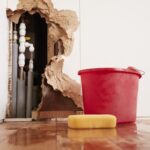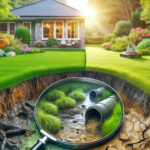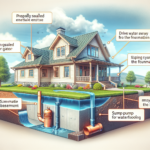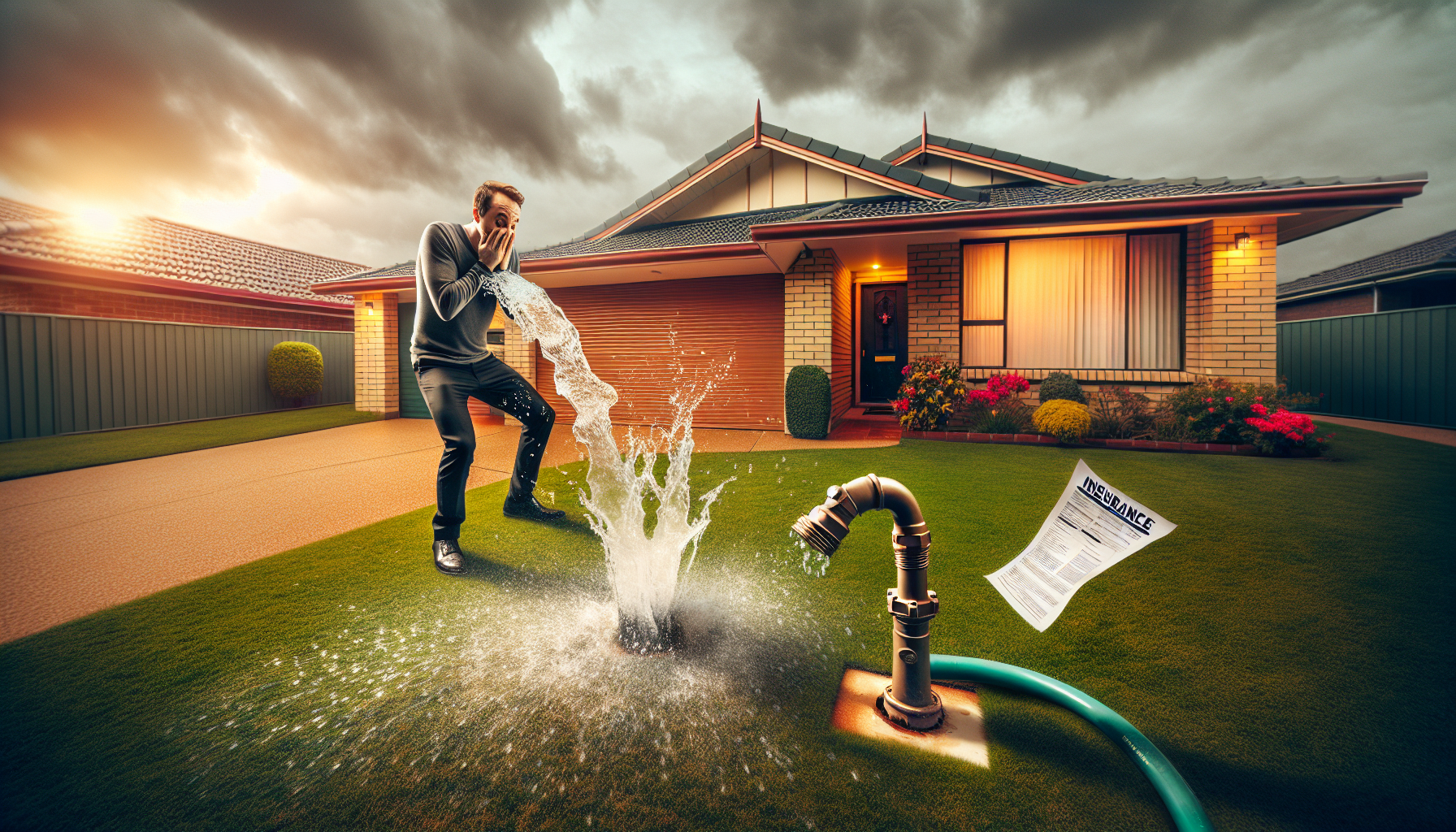Water damage, a homeowner’s nightmare, can emerge from myriad sources, with hose bibs, also known as sill cocks or spigots, frequently implicated in burst pipes and plumbing leaks. This kind of water damage not only disrupts the tranquility of a home but also poses a significant challenge to manage, often invoking concerns about homeowners insurance coverage and the intricacies of insurance claims. The importance of understanding the relationship between hose bibb bursts, one of the common causes of water damage, and homeowners insurance cannot be overstated, as it directly impacts the financial and emotional toll of such incidents.
This article ventures into the depths of water damage related to hose bibb busts, shedding light on key areas including the coverage provided by homeowners insurance, the conditions under which a hose bibb burst might be covered, and the steps to take immediately following such an incident. It further guides homeowners through the process of filing a water damage insurance claim, emphasizing the significance of deductibles, subrogation, and the selection of insurance coverage that best suits their needs. Moreover, it underscores preventive measures to avoid future hose bibb busts and the pivotal considerations for choosing the right homeowners insurance policy, aiming to arm readers with the knowledge needed to navigate the complexities of water damage and insurance claims with confidence.
Understanding a Hose Bibb Bust
What is a Hose Bibb?
A hose bibb, often referred to as an outdoor faucet or technically termed “sillcock,” is a water faucet positioned on the exterior of a home. It includes a valve that controls the flow of water through the faucet, making it a critical component for garden and lawn maintenance. Despite their ubiquity and ease of installation, hose bibbs are typically inexpensive and can be prone to issues due to their exposure to external elements and the quality of materials used.
Common Causes of Hose Bibb Busts
- Frost and Freezing Conditions
- Hose bibbs are highly susceptible to freezing temperatures, which can cause the water inside to expand and lead to bursting. This is particularly common when hoses are left attached, allowing water to remain in the spigot and freeze.
- Wear and Tear
- Over time, the components of a hose bibb, such as the stem washer or the valve itself, can degrade. Outdoor exposure can accelerate this wear, leading to leaks or complete failure of the bibb.
- Improper Installation
- If not installed correctly, hose bibbs can experience issues such as water pooling in the stem. This can be exacerbated in winter when improper slope or positioning leads to freezing risks.
- Lack of Maintenance
- Regular maintenance is crucial for extending the lifespan of hose bibbs. Neglecting simple tasks like disconnecting hoses or checking for leaks can lead to significant damage.
- Material Quality
- Many hose bibbs are made from materials that may not withstand harsh weather conditions or prolonged use. Cheaper models might offer short-term savings but can lead to increased risk of busts.
By understanding these common causes, homeowners can take proactive steps to minimize the risk of a hose bibb bust, thereby protecting their property from potential water damage.
Homeowners Insurance Coverage for Water Damage
What Types of Water Damage Are Covered?
Homeowners insurance policies typically cover water damage that is sudden and accidental. This includes scenarios where an internal water source causes damage, such as a burst pipe or an overflowing appliance. For instance, if a water heater ruptures or a pipe upstairs bursts, saturating the ceiling below, homeowners insurance may help pay for the necessary repairs to drywall and other affected areas. Additionally, if a washing machine’s water supply hose fails and damages the flooring, the policy would likely cover the repair costs for the ceiling and floor, though not the appliance itself.
Damage resulting from specific weather-related incidents is also often covered. For example, if a windstorm damages a roof allowing rain to infiltrate and damage the home’s interior, or if debris breaks a window during a storm leading to water damage, these instances would typically be covered by homeowners insurance. Similarly, if a pipe bursts unexpectedly and water damages the walls or personal property within the home, such as furniture or electronic devices, both dwelling and personal property coverage may apply.
Exclusions in Homeowners Insurance Policies
Despite the broad protection offered for sudden and accidental water damage, there are notable exclusions in standard homeowners insurance policies. Damage caused by floods, defined as rising or surface water from external sources (like rivers, lakes, or heavy rain pooling around the house), is generally not covered under a standard policy. Homeowners in areas prone to flooding will need to consider purchasing separate flood insurance through the National Flood Insurance Program.
Another common exclusion is for water damage resulting from poor maintenance or neglect. For instance, if a homeowner ignores a leaking faucet for an extended period, and this negligence leads to significant damage, the insurance policy typically will not cover the repair costs. Similarly, gradual damage from slow leaks, seepage, or mold that develops over time due to unresolved maintenance issues are usually excluded from coverage.
Additionally, most policies do not cover the source of the water damage. This means that while the policy may pay for the cleanup and repair of damage caused by a broken appliance, it will not cover the costs to repair or replace the malfunctioning appliance itself. Also, water backup from external sewers or drains is not typically covered unless specific additional coverage for these risks is purchased.
Understanding these exclusions is crucial for homeowners to ensure they are adequately protected and to avoid surprises during the claims process.
When Is a Hose Bibb Bust Covered by Insurance?
Criteria for Coverage
Homeowners insurance generally covers water damage that is sudden and accidental. This includes scenarios like a burst pipe due to unexpected reasons such as freezing conditions or sudden mechanical failure. For instance, if a hose bibb bursts because of a rapid drop in temperature causing the water inside to freeze and expand, this type of incident is typically covered under the dwelling coverage portion of a homeowners insurance policy. It is imperative for homeowners to understand that any damage must result from unforeseen circumstances.
- Sudden and Unexpected Occurrences: Damage must be sudden and accidental, not due to gradual deterioration or lack of maintenance.
- Immediate Damage: The coverage usually includes immediate water damage resulting from the burst. This could cover repairs to walls, flooring, and other parts of the home impacted by water.
- Maintenance Requirements: Policies often stipulate that homeowners must maintain their plumbing systems to prevent avoidable risks, such as detaching garden hoses before freezing weather and ensuring proper insulation of pipes.
Real-life Examples
To illustrate when a hose bibb bust might be covered by insurance, consider these scenarios:
- Accidental Damage During Yard Work: If a homeowner accidentally damages the water line while digging in the yard, leading to a hose bibb burst, the cleanup and repairs are typically covered. This is considered a sudden and accidental event.
- Frozen Pipe Bursts: During a severe cold snap, a hose bibb that is not adequately winterized may freeze and burst. If the homeowner had taken all the recommended precautions such as insulating the pipes and detaching hoses, the insurance would likely cover the damages.
- Improper Installation: If a burst occurs due to improper installation of the hose bibb, where it was installed at an incorrect angle preventing water from draining and leading to freezing, this might also be covered. It is crucial that the installation errors are accidental and not due to negligence.
For each of these examples, homeowners should ensure they have documented all maintenance efforts and the sudden nature of the incident to support their insurance claims effectively.
Steps to Take When a Hose Bibb Busts
Immediate Actions
- Shut Off the Water Supply: Locate the main shutoff valve for your home’s water supply and turn it off immediately. This action prevents more water from flowing through the burst hose bibb, minimizing further damage to your property.
- Open the Hose Bibb Spigot: While it may seem counterintuitive, opening the spigot can help to relieve any built-up pressure in the frozen pipe, which can aid in preventing further bursts.
- Apply Heat: If the hose bibb has frozen, wrap it with towels or rags and pour boiling water over them to thaw the ice. Alternatively, a hair dryer or heat gun can be used to gently warm the pipes.
- Inspect for Damage: Assess the hose bibb and surrounding pipes for any visible signs of damage like cracks or leaks. This will help in determining the next steps for repair.
Documenting the Damage
- Photograph All Damage: Before cleaning up or making temporary repairs, take detailed photos or videos of the damaged hose bibb and any affected areas. This is crucial for insurance claims.
- Keep Records of the Event: Document the date and time of the burst, how it was discovered, and the immediate steps taken to mitigate the damage. These records can be vital during the insurance claims process.
- Contact Your Insurance Company: Review your homeowner’s insurance policy to understand coverage limits and procedures. Contact your insurance provider to report the incident and start the claims process.
- Consult with Professionals: Consider hiring a water damage restoration specialist or a plumber to assess the situation. They can provide professional advice on repairs and help prevent future incidents.
By following these steps, homeowners can effectively manage the situation when a hose bibb bursts, reducing the risk of extensive water damage and facilitating a smoother insurance claim process.
Filing a Homeowners Insurance Claim
How to File a Claim
Filing a homeowners insurance claim for water damage begins with immediate action. As soon as the damage is discovered, homeowners should document the extent of the water damage meticulously. This involves taking detailed photos and videos of all affected areas and items. These visual records are crucial as they provide undeniable proof of the damage, which supports the claim.
The next step is to contact the insurance company without delay. Homeowners should provide their policy number, the date and time the water leak was discovered, and a thorough description of the damage. It’s essential to include any measures taken to mitigate further damage, such as turning off the water supply or using towels to absorb the water.
Tips for a Successful Claim
- Documentation is Key: Keep all evidence organized and readily accessible. This includes photographs, videos, a detailed list of damaged property, receipts for any immediate repairs, and quotes from contractors. The more detailed the documentation, the smoother the claims process will be.
- Cooperate Fully with the Adjuster: Homeowners should be prepared to answer all questions from the insurance adjuster and provide all requested documentation. They should also allow full access to the property for a thorough inspection. If there’s any disagreement with the adjuster’s assessment, homeowners can consider hiring a public adjuster who advocates on their behalf.
- Engage Professional Help: Consulting with water damage restoration professionals can provide an accurate estimate of the repair costs, which can be vital when dealing with insurance claims. These professionals can also help in preventing further damage, thus strengthening the claim.
- Prompt and Clear Communication: Communicate promptly with the insurance agent and ensure that both the insurance agent and company are informed about the situation. If the dedicated agent is unavailable, follow up during business hours to ensure the claim is being processed.
- Review and Understand Your Policy: Knowing what your insurance covers and the limits of your coverage is crucial. This knowledge can prevent surprises during the claims process and help in making informed decisions about additional coverage, such as flood insurance or water backup coverage.
By following these guidelines, homeowners can navigate the often complex process of filing a water damage insurance claim, ensuring they receive the compensation needed to restore their property effectively.
Preventive Measures to Avoid Hose Bibb Busts
Regular Maintenance
To prevent hose bibb busts, homeowners must prioritize regular maintenance. Starting in the mechanical room, homeowners should identify two lines typically marked as front and rear. Initially, these knobs are in the ‘on’ position and should be turned downward to switch them off. Subsequently, one should proceed outside to open the faucet fully, allowing any water within the line to drain out. Upon returning indoors, it is crucial to locate a small container that fits between the pipework to collect water from the bleeder valve. This valve helps drain any remaining water in the line. After draining, the valve should be screwed back in finger-tight without using excessive force.
In preparation for colder months, it is essential to detach garden hoses to prevent water from being trapped and freezing inside, which can lead to bursts. Homeowners should also inspect hose bibbs for leaks or signs of wear periodically and replace any worn components like washers or O-rings to maintain their functionality and prevent leaks.
Installing Frost-Free Hose Bibbs
Installing frost-free hose bibbs offers an effective solution to prevent water in pipes from freezing during the winter. These bibbs feature an elongated stem or shaft that extends into the interior of the home, ensuring that the valve controlling the water supply is located within a warmer environment. This design prevents the water from freezing, which is a common issue with standard hose bibbs in colder climates.
A critical aspect of frost-free hose bibb installation is ensuring a slight downward slope towards the exterior. This slope allows residual water to drain out after the valve is closed, leaving the pipe empty and significantly reducing the risk of freezing and bursting. Homeowners should ensure that the installation includes safety valves located in the heated part of the house and that the spout is positioned lower than the water supply to facilitate effective drainage.
Regular maintenance of frost-free hose bibbs is also crucial. This includes bi-annual inspections before winter and in spring to check for signs of wear or damage, such as leaks or corrosion at the handle, spout, and connection points. Early detection of these issues allows for timely repairs, extending the life of the hose bibb and safeguarding the home against potential water damage.
How to Choose the Right Homeowners Insurance Policy
Understanding Policy Terms
When selecting a homeowners insurance policy, understanding the terms and conditions is crucial. Homeowners insurance is typically a package policy, meaning it covers both property damage and liability or legal responsibility for injuries or damages caused by policyholders or their family members, including pets. However, standard policies do not cover all types of damage; for instance, flooding and earthquakes are usually excluded. These require separate policies or endorsements.
Key coverage options within a standard policy include:
- Structure of Home: Covers repair or rebuilding costs for the home and attached structures if damaged by a covered peril.
- Personal Belongings: Provides coverage for items like furniture and clothing, typically at 50 to 70 percent of the structure coverage.
- Liability Protection: Protects against legal claims from injuries or damages caused by the policyholder or their family.
- Additional Living Expenses: Compensates for living costs if the home is uninhabitable due to covered damage.
Understanding these components helps homeowners make informed decisions about the type and extent of coverage they need.
Consulting with Insurance Experts
Engaging with insurance experts can significantly aid in choosing the right homeowners insurance policy. Experts like insurance agents or brokers who are well-versed in the field can offer invaluable advice tailored to individual needs. Here are some steps to effectively consult with insurance experts:
- Assess Your Needs: Before meeting an expert, homeowners should evaluate their property, belongings, and potential risks. This helps in discussing specific coverage needs.
- Expert Credentials: Ensure the expert has relevant qualifications, such as a CPCU (Chartered Property Casualty Underwriter) or RPLU (Registered Property Liability Underwriter) designation, indicating a deep understanding of insurance policies and coverage nuances.
- Review Current Coverage: Experts can help review existing policies to identify any gaps in coverage or opportunities for cost savings. Annual reviews are recommended to adjust coverage as circumstances change.
- Compare Quotes: Insurance experts can provide quotes from multiple insurers to compare coverage options and premiums, ensuring competitive pricing and adequate protection.
By leveraging the knowledge of insurance professionals and understanding the fundamental terms of a policy, homeowners can secure comprehensive coverage that best suits their needs and provides peace of mind.
Conclusion
Through this comprehensive exploration, we’ve navigated the complexities surrounding hose bibb busts and the consequential significance of homeowners insurance in such scenarios. We’ve underscored the crucial interplay between understanding policy coverage and the importance of preventive measures to safeguard against potential water damage. By emphasizing both the actions homeowners can take to mitigate risks and the steps to navigate the insurance claim process successfully, this article aims to empower homeowners with the knowledge to manage hose bibb-related water damage confidently.
Reflecting on our discussion, the insights garnered highlight not only the immediate steps to take following a hose bibb bust but also the broader implications of choosing the right insurance coverage that aligns with homeowners’ needs. The importance of regular maintenance, informed insurance policy selection, and proactive engagement with insurance professionals cannot be overstated in their collective capacity to afford homeowners peace of mind. As we conclude, it is the informed and prepared homeowner who stands the best chance of mitigating the distress and financial impact of water damage, thereby ensuring a more secure and resilient home environment.
FAQs
- What are common reasons for the denial of a water damage claim?Insurers typically deny water damage claims when the damage results from neglect or lack of maintenance rather than being sudden or accidental. For example, a claim might be rejected if a roof leak was due to long-term neglect or if an appliance’s leak could have been prevented with regular maintenance.
- What should you avoid saying to a home insurance adjuster?It is crucial not to admit any fault or even partial fault when speaking with a home insurance adjuster. Avoid using language that suggests apology or blame, as this could impact the outcome of your claim.
- Does homeowners insurance cover water damage caused by a faucet left running?Yes, homeowners insurance generally covers water damage that is sudden and accidental, such as water damage from a faucet left running. This coverage applies regardless of whether the incident was your fault or that of someone else, like a child.
- How can you successfully file a water leak insurance claim?To ensure your water leak insurance claim is successful, follow these steps:
- Identify the source of the water and take reasonable measures to stop further flow.
- Verify that your home insurance policy covers the type of water damage you have incurred.
- Contact your insurance agent to report the claim.
- Consider hiring a professional water damage clean-up company if necessary.
We represent home and business owners and have vast experience with the following types of claims:
- Fire and smoke damage claims
- Water damage claims
- Flood damage claims
- Theft and vandalism damage claims
- Snow and ice damage claims
- Building collapse claims
- Wind and hail damage claims
- Catastrophic damage claims
- Roof leaks
- Blown off shingles & siding
- All plumbing leaks
- Toilet overflow
- Burst Pipes
- Frozen Pipes





